Displaying items by tag: ITRA
Irish Team Racing Association Unveils Packed 2024 Calendar in Effort to Grow the Sport Across Ireland
In response to a surge in the popularity of team racing in Ireland over recent years, the Irish Team Racing Association (ITRA) has announced a packed 2024 calendar aimed at further growing the sport across the country.
The announcement followed the election of a new ITRA committee at an AGM held in late 2023.
The ITRA Committee intends to bring adults of all ages and abilities into team racing over the coming years through an array of events running between April and October. While team racing has been immensely popular amongst young adult sailors across the country for a long time, the association is hopeful that a full calendar will allow for continuity and growth in the community after university and beyond.
In addition to this, the ITRA is also aiming to grow women's participation in helming and in the sport in general. A "Take the Helm" event is set to take place this April 13th and 14th in Malahide, with a second event provisionally scheduled for September. Currently, training sessions are being organised in the south, east and west of the country to help get more women helming ahead of the event.
The packed calendar is also set to include a mixed pairs event, a 2K Keelboat event before concluding with the ITRA Nationals in Baltimore in October, which will be held over three days for the first time.
Many in the sailing community are excited about the ITRA's plans for growth and development of team racing in Ireland. With the already established Irish University Sailing Association (IUSA) and Irish Schools Team Racing Association (ISTRA), the ITRA's efforts are expected to bring even more attention and growth to the sport in the country.
THE IRISH TEAM RACING ASSOCIATION CALENDAR 2024
- Take the Helm, Malahide Sailing Club, April 13th & 14th
- Royal St George Invitational, RStGYC, May 25th & 26th
- Mixed Pairs Team Racing Event, Galway, June 22nd & 23rd
- Take the Helm 2, Venue TBC, September 21st & 22nd (Provisional)
- 2K Keelboat Team Racing, Dun Laoighaire, September 28th & 29th
- ITRA National Championships, Baltimore, October 18th-20th
Forum For Irish Team Racing Discussion Opens Online
#teamracingforum – News that the Optimist dinghy class in Ireland is once again organising a team racing event, together with the announcement of plans for junior event in the Royal St George and the continuing development of 2K team racing in Europe confirm that team racing offers competitive sailing for all ages. With this new impetus the Irish Team Racing Association have set up a forum to allow 'in depth discussion' of a large number of topics regarding team racing and its development in Ireland.
The forum is reserved for active participants in team racing organised by ITRA. Delegates from IUSA, the Irish National Schools Sailing Association will be invited to participate if they do not qualify for access directly. As membership of ITRA is one topic that needs to be addressed access to this forum is limited to sailors, race committee and umpires who took part in the ITRA Nationals in 2013 and 2014.
The forum registration process is here
Irish Team Racing Association To Select World Championship Teams
#teamracing – The ISAF Team Racing Worlds will be sailed in Rutland UK on 19th-24th July 2015. The ISA has already reserved places for an open team and a youth team. Other places may become available during the entry process.
The Irish Team Racing Association will select Open and Youth teams to represent Ireland at this event.
Teams shall consist of six sailors, including at least one male and one female competitor. The age limit for Youth teams is under 19 on 31st December 2015. All competitors must be eligible to represent Ireland under ISAF Eligibility (Regulation 19).
On the basis of information supplied by the candidate teams the Selection Committee will select a number of teams to compete in a trial event. Criteria for selection will include consideration of the individual sailing CVs of all six team members, and results in team racing in Ireland and abroad, particularly in 2013 and 2014. Preference will be given to teams that have already demonstrated their capacity to compete in international competitions.
A one day, multiple round robin event will be sailed. This event will be sailed in Fireflies, and the event is planned for Saturday 14th February in the Royal St George Y.C. Dun Laoghaire.
Selected teams will be nominated by the Irish Team Racing Association for approval by the Irish Sailing Association to represent Ireland at the ISAF Team Racing Worlds.
Irish Teams Selected for Team Racing World Championships
After the first round the home team, the "George Gladiators" were demonstrably the leading senior team. They won all their races, and in all but one race finished in first and second place. The "Supertroopers", mainly University of Limerick graduates, were second with 5 wins and UCD1 4 wins. These 3 teams proceded to the second round, sailing each other once. In order to qualify UCD1 needed to beat both other teams. Unfortunately, they lost their first race to the "Gladiators". The "Gladiators" then relaxed, loosing their only race of the day to the Supertroopers, who then beat UCD1.
In the Youth event, Schull1 won 3 races, Schull2 2 races. This was enough to ensure selection.
As a result of these trials the Irish Team Racing Association will be recommending the following teams to represent Ireland (subject to meeting all eligibility requirements) at the ISAF World Team Racing Championships, to be sailed in Schull,West Cork in August:
Ireland 1
Marty O'Leary, Brian Fenlon, Sam Hunt, Jodie-Jane Tingle, Andrew Fowler, Rachel Guy
Ireland 2
Darragh O'Connor, Hannah Herlihy, Kevin Stollard, Rachel O'Brien, George Kingston, Tom Martin
Ireland Youth 1
Connor Miller, Ellen O' Regan, Oisin O'Driscoll, Katie Moynihan, Jay Jay Stacy, Kaspar Snashall
Ireland Youth 2
Fionn Lyden, Tomas O'Sullivan, Darragjh McCormack, Mark Hasset, Pearse O'Flynn, Gleb Romantchik































































